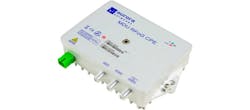Aurora Networks RFoG OBI-free-R-ONU
Optical beat interference (OBI) occurs when two RFoG optical network units (ONUs) transmit back to the headend at the same time, on the same optical wavelengths, into the same optical receiver. This results in an increase in the noise floor across the return path and increased codeword errors. The probability of OBI is a factor of the number of customers connected and the amount of traffic being transmitted.
Aurora's new OBI-free, multi-dwelling unit (MDU) ONUs eliminate the occurrence probability of OBI by managing the upstream wavelength. Offering full support for DOCSIS 3.0 and beyond, the solution allows operators to deploy full multi-channel and bonded channel options. The OBI-free ONIs are SCTE-compliant and operate at 1,310 nm or 1,610 nm in the upstream.Diamonds judges noted that RFoG's problem gets worse with DOCSIS 3.0 and were happy to see Aurora tackling this in the ONU instead of relying on headend equipment to solve the issue.www.aurora.comSee them at Cable-Tec Expo, Booth 1944Return to the BTR Diamond Technology Reviews Elite.
